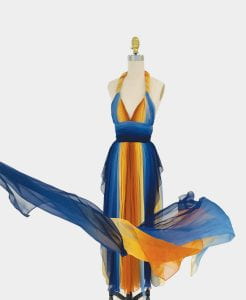This online blog post features materials protected by the Fair Use guidelines of Section 107 of the US Copyright Act. All rights reserved to the copyright owners.
Blog post by Perla Imseeh
The past and the present. Stability and movement. Orange and blue. How could all these contradictory concepts be explored in only one garment?
Held at the Cornell Fashion and Textile Collection, the Givenchy Rainbow Dress carries years of history, beauty, and culture. A bright summer gown that dates back to the 1960’s but can easily be found beaming through a glass window at a French boutique now in 2023. A rebellion, this dress defies and juxtaposes every design theory concept attached to it, every fashion trend of its period, and every social stigma surrounding it. It unites polar opposite design elements into one exceptional embodiment of French fashion.
One glimpse at the dress and your eyes are instantly drawn to its striking complimentary colors, orange and blue. Undoubtedly, these colors paint the dress with saturation and excitement. However, in theory, when complementary colors are brought closer together through a gradient, they tend to neutralize one another and desaturate the medium they are adorning. Givenchy manages to find a loophole to this theory by positioning the light-yellow color between the complements and disrupting the gradient (see Figure 2). Who knew adding a subtle color would intensify the vibrancy of a dress? Not Michel Chevreul.
We established that the luminous colors of the dress capture the eyes of any onlooker. However, it is the creases within the draping of the fabric that drag our eyes across the dress from side to side and up to down. The pleats create the effect of vertical lines going down the dress which elongate the body of the wearer by creating the illusion that they extend beyond the surface of the dress. Similarly, the horizontal rouching of the fabric along the belt widens the waist of the wearer. Elongated legs and a widened waist eliminating the appearance of curves in the body; two key features of the ideal female body type during the 1960s. Using the construction techniques of pleating and rouching to summon the power of line, Givenchy moulds their users into the beauty standards of their time.
I can imagine the feeling of flaunting the Givenchy Rainbow Dress; sensing a light breeze passing through each fold of its silk chiffon material, the scarf hanging loosely off my shoulders and swaying with each step I take, the pleats opening up to reveal the details of the fabric. An overpowering amount of movement and action. But guess what? Theoretically, a combination of vertical and horizontal lines creates a sense of stability. Yet, even when in a static position, the dress looks like it is in motion – an effect created by diagonal lines which Givenchy discreetly includes throughout the dress. You can spot them in the V-shaped neckline, the slits on the sides, and the twisted straps (Figure 3). Once again, this unconventional dress defies a theoretical design concept. “It’s a fabulous thing to give life to fabric, to make something move well.” says the founder, Hubert De Givenchy which he accomplishes by using a lightweight material which floats delicately and adds rhythm to the garment.
Time and time again we are seeing how this dress evokes the unexpected. Aside from design theories, the Givenchy Rainbow Dress also subverts society’s expectations of female fashion in France during the 1960s. The 60s was the beginning of second wave feminism which focused on women’s agency over their bodies. Simone De Beauvoir, a French woman, and the face of second wave feminism, blames high fashion French designers whose collection’s “imprisoned women in waist cinching corsets” for hindering the success of second wave feminism (Thompson, 2002). “I am of tradition, but that doesn’t mean I have an old outlook on life.” says Mr. Givenchy as he advocates for social development through his fashion unlike other French designers of the time. The Rainbow Dress is a perfect example of his artistic fights for feminism. Its open back and deep V-cut neckline leave no chance for an imprisoning corset underneath. The skirt falls loosely beside the legs of the wearer with no enlarging petticoat or bustle. The dress’s proportions align with the proportions of a natural body to show off the beauty of any body in any dress. “Everyone wants to have the liberty to wear anything, everything.” is the philosophy of Mr. Givenchy which drives him to promote second wave feminist ideals.
“Everything is so difficult now” says Mr. Givenchy. “One season there are broad shoulders, then none at all. A short dress, then a long dress. There’s no continuity. To change just because of change, that is not my idea at all.” He longs for design classics and ubiquity which he achieves through the rainbow dress. Because of its attempt to avert submissive clothing, the silhouette of the dress looks as if it has traveled from contemporary fashion back to the 60s. It holds the beauty of both the past and the present and therefore stands the test of time.
The Givenchy Rainbow Dress is more than just a luminous garment deposited in the Cornell Fashion and Textile Collection. It is a fight for equality, a representation of history, and a learning experience; although it deviates from theory discussed in FSAD 1250: Fashion, Art, and Design Thinking. Givenchy saturates a gradient of complementary colors, brings action to horizontal and vertical lines, and steers away from social trends and expectations of the 60s to construct a paradox in fashion!
Works Cited:
Fischer, S., Angwin, J., Nguyen, H., Page, B., Ens, L., & Andrew. (2021, February 11). Neutralizing color. Just Paint. Retrieved December 11, 2022, from https://justpaint.org/neutralizing-color/
Hays, K. (2018, March 16). Fashion scoops. WWD. Retrieved December 11, 2022, from https://wwd.com/fashion-news/fashion-scoops/
How beauty standards have changed. Country Girl Management – US. (n.d.). Retrieved December 11, 2022, from https://www.countrygirlmanagement.com/free-stuff/blog/how-beauty-standards-have-changed/#:~:text=Things%20that%20were%20celebrated%20in%20the%2060s%20include%3A,Small%20shoulders
Thompson, B. (2002). Multiracial Feminism: Recasting the Chronology of Second Wave
Feminism. Feminist Studies, 28(2), 337–360. https://doi.org/10.2307/3178747
Author Bio:
Perla Imseeh is a diligent and motivated student from Amman, Jordan. She is currently pursuing her undergraduate degree in Fashion Design and Management at Cornell University’s College of Human Ecology. Along with her major, Perla is also pursuing a minor in Business, demonstrating her keen interest in both the creative and business aspects of the fashion industry.



